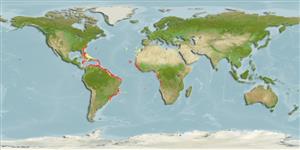Malacostraca |
Decapoda |
Portunidae
Environment: milieu / climate zone / गहराई सीमा / distribution range
पारिस्थितिकी
बेनथोपिलाजिक; खारा; गहराई सीमा 1 - 421 m (संदर्भ 105052). Tropical; 35°N - 31°S, 82°W - 14°E
Atlantic Ocean: from southeastern Florida to Brazil rarely in Bermuda and North Carolina, also in the Cape Verde Islands and along the African coast from Mauritania to Angola.
Length at first maturity / आकार / Weight / Age
परिपक्व अवधि: Lm ? range ? - ? cm Max length : 10.0 cm CW पुल्लिंग / अलिंग; (संदर्भ 417)
In shallow littoral environments, typically from intertidal pools to 3 m (Ref. 105199). Inhabits shallow salt water on sandy or sandy mud bottom (Ref. 435) in brackish waters of estuaries (Ref. 417). Also found on algae and grass flats, sandy beaches, rocky pools, eroded coral bases (Ref. 105199), coral reef (Ref. 121879), oyster bars (Ref. 105199), and edge of mangroves (Refs. 105199, 121880). Rarely found in the open sea, from the intertidal to depth of 25 m (Ref. 121880). Associated with the barnacle Chelonibia sp. (Ref. 105200). In general, portunids are opportunistic omnivores with preference for animal prey (Ref. 100840).
Life cycle and mating behavior
परिपक्व अवधि | पुनरुत्पत्ति | मछलीऔ का अंडे देना | Eggs | Fecundity | Larvae
Members of the order Decapoda are mostly gonochoric. Mating behavior: Precopulatory courtship ritual is common (through olfactory and tactile cues); usually indirect sperm transfer.
Fischer, W., G. Bianchi and W.B. Scott (eds.) 1981 True Crabs. 6: pag.var. In FAO species identification sheets for fishery purposes. Eastern Central Atlantic (fishing areas 34, 47; in part). Canada Funds-in-Trust. Ottawa, Department of Fisheries and Oceans Canada, by arrangement with the Food and AgriculturesOrganization of the United Nations, 1-7: pag.var. (संदर्भ 435)
IUCN Red List Status
(संदर्भ 130435: Version 2025-1)
CITES status (संदर्भ 108899)
Not Evaluated
CMS (संदर्भ 116361)
Not Evaluated
Threat to humans
Human uses
मात्स्यिकी: व्यापारिक
| FishSource |
साधन
अधिक जानकारी
Trophic EcologyFood items (preys)
संघटक आहार
आहार खपत
परभक्षी
Life cycleपुनरुत्पत्तिपरिपक्व अवधिFecundityमछलीऔ का अंडे देनाEggsEgg developmentLarvae PhysiologyOxygen consumption
Human RelatedStamps, coins, misc.
इंटरनेट स्रोत
Estimates based on models
Preferred temperature
(Ref.
115969): 14.1 - 24.4, mean 17.5 (based on 89 cells).
Fishing Vulnerability
Low vulnerability (10 of 100).
